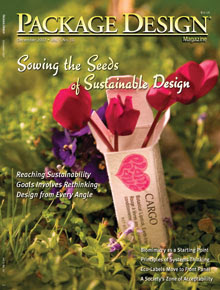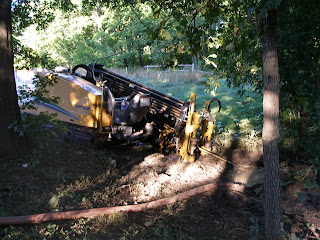Package Design Magazine Runs Permaculture Editorial
 It is also printed below.
It is also printed below.I am very happy to announce Permaculture Design will be on the course list
for MCAD's (Minneapolis College of Art and Design) groundbreaking
Sustainable Design Certificate Program. MCAD will be offering the 50 hour
on-line course starting in July 2008.
The socially, vocationally and culturally diverse cross section of
students in the program will apply Permaculture to their respective applications in art, design and life systems.
Through one visionary act by Wendy, Permaculture will be highlighted in a new college text book on sustainable design to be released this spring by Wiley publications, the linked magazine article above for national distribution was released this month, and MCAD will feature Permaculture as part of its design curriculum.
The Article:
Permaculture Principles in Package Design
Nothing exists outside a relationship. Everything is related in the working systems of nature, economics or package design. A designer that does not take into account the effect delivered works will have on users, resources or society, depletes the designs potential and future viability. Systems Thinking requires that we develop the awareness and skills to define and design the Functional Relationships[i], which reduces waste and enhances, yield from existing relationships. Permaculture is a practice that uses a set of principles to assure the long-term viability of self-sustaining systems in agriculture. Permanent + Agriculture is Permaculture.
In the 1970s Ecological Activist Bill Mollison of Australia, retreated from popular culture to study and develop a set of principles that would assure success in ecological minded farming. His resulting 34 principles for Permaculture where refined by his close associate David Holmgren over 25 years of practice.
In his book Permaculture: Principles and Pathways beyond Sustainability (2002) Holmgren lays out his refined list of twelve principles for sustainable living systems. These powerful concepts, here applied to package design, can open a new world view of our responsibility as designers and possibilities as people.
- OBSERVE AND INTERACT
The Omnipresence of Relationships. Careful observation of the environment in which our work is used gives us power to respond with new ideas for design, materials and integration. Knowing the environment our materials come from, and the ultimate end of the product is an important step in defining the parameters of our packaging strategy. The life cycle of a package cannot be ignored in the process. Interaction with consumer or warehouse is not the end of the relationship, the package lives on in an environment as inert or toxic waste, fuel, or a second extended life in another purpose. As an extension of ourselves we interact through it. - CATCH AND STORE ENERGY
The Real Lifecycle, Assets and Waste. The “paid” time we spend in developing designs and the funds invested in the ultimate container creates an asset. If the ensuing container is seen as “stored energy” and a potential marketing resource beyond the trash bin; if it has a second purpose beyond its initial use, it has additional stored potential for the end user. Harnessing this stored potential for marketing and extended customer interaction increases the return on the packaging investment. Short sightedness leaves for lost opportunity. What can we do with the unused potential?
- OBTAIN A YIELD
All our efforts in packaging must ultimately produce results. The engineering, marketing, corporate, and government requirements for “allowable” designs must be met. Yet the ultimate yield of the package is not a result of any of these singular dictates. Because of these, the package has multiple functions and thus multiple yields. Some of these are: structure to protect and hold the contents till used, shelf or appetite appeal to increase or keep sales; brand recognition for other products; and regulated or standardized information for public safety. These secured, the designer determines the final yield in the life cycle. Few others are aware or care.
- APPLY SELF REGULATION AND FEEDBACK
Within the cubicle, the designer is in total control of the direction of a package. Innumerable options are assessed and personal creativity blends with good design. Effort is used to find suitable materials. Personal ethics are used to specify which of these materials are acceptable. A proposal is made to use ecologically minded vendors and resources, or not. Questions are asked of consultants and suppliers, or not. Excessive waste is minimalized, or not
- USE AND VALUE RENEWABLE RESOURCES AND SERVICES
Using renewable resources for transient purposes such as short-lived packaging may seem practical. However, valuing the materials as limitless is naïve. The cheapest paper has value and uses non-renewable energy to be produced, processed and shipped. A large portion of renewable materials inherent cost is in production and transportation. Understanding the source of material and its processing methods is central in understanding the ecological cost or sustainable value of the material.
- PRODUCE NO WASTE
In the electronic age, paper is run through printers as if it came from the sky. Which it does, by sunlight, water, nitrogen and carbon dioxide. But from that point however the waste starts, in processing, trimming, shipping, and round filing. Keeping proofs to a minimum and using electronic PDFs surely diminishes wasted paper. Then putting the PC to sleep or better “off” when out of the office reduces more. In the quest to produce no waste one must ultimately limit consumption. If you don’t buy it, wrap it, bag it, transport it, unwrap it, or toss it. It cannot be waste. If an item can be sold without a package (abosolute heresy), where is the waste? Again the second life of all things can extend its useful period and catch and save energy otherwise used in its disposal.
7. DESIGN FROM PATTERNS TO DETAILS
Changing the pattern in a department, or corporation is hard. Yet one person can make a small adjustment each time an opportunity arises and affect change. Broad patterns of corporate culture can be shifted with small details. A pattern is made of small details repeating over and over. Gradual shifts in materials, modest requirements of suppliers and eco-options for employees will set the corporate culture on a course for change. An award for the company for a green design goes a long way. Observation of trade trends to eco-minded design can be highlighted.
8. INTEGRATE RATHER THAN SEGREGATE
Compartmentalized resources in a company reduce the potential solutions. Designers working with engineers at the inception of a product can add to the functionality and aesthetics. Status Quo rationale for engineering design can be opend to other possibilities by simple questions. Designers can understand basic concerns of engineers. Teams integrated with diverse deciplines add value and understanding solving problems before they have a chance to exist.
9. USE SMALL AND SLOW SOLUTIONS
Using the smallest, cleanest, simple solution to a problem makes for less waste and faster turn– around. Answering the basic question, “What does this really need to do?”, may help define the solution, then gradually make for opportunities to advance new design improvements. Build momentum with gradual changes and small efficiencies when revisited. Map possibilities.
10. USE AND VALUE DIVERSITY
Using only one supplier, one method and one material makes design vulnerable to outside forces and internal disturbances. Like keeping all the creative eggs in one basket or all the materials from one warehouse. A diverse source of intelligence ensures a broad scope of reference. One plastic does not a selection make and a favorite medium may not be the best. Appreciate diversity in sources, materials and the benefits of each.
- USE EDGES AND VALUE THE MARGINAL
To be defineable one needs to be extreme. To ride the edge of technology, design, engineering means to be noticed. The leading edge, with all its resistance and polishing. The bleeding edge, where new ideas are tested and challenged. Resources collect at the edges waiting for a purpose or the excitement. Win or lose there is knowledge to be gained. Nothing is wasted on the edge. It is the highest point of concentration. The marginal areas are to be explored. Opportunity missed and ignored resources are in the margins. Both edge and margin are a place on transition. The edge is where the action is. The Margin is where things are waiting for change. It can be wide or narrow.
- CREATIVELY USE AND RESPOND TO CHANGE
Nothing sits still for very long. Keeping in mind everything is moving and adjusting position, the ups and downs are time to be creative. Nature fills all voids. Skills untapped suddenly find use. Solutions lying in wait, shelved long ago, find a need. It is an opportunity to be creative while the paradigm shifts and the scripts are being written. A disturbance in the “natural order” is an opening for both weed and flower. The seeds have always been there or will soon blow in, catching on the bare soil. Even if the weeds take hold, they are but place holders while the deeper plants make roots and prepare to emerge. Nothing is wasted, unless there is nothing to respond. In time, something always will.
[i] David Holmgren, The Essence of Permaculture 2002
Daniel Halsey is a Certified Permaculture Designer, Graphic Designer and Food Photographer.
He lives with his wife Ginny in SouthWoods of Spring Lake, Minnesota, a 25-acre wetland with an Edible Forest Garden installed by the Twin Cities Permaculture Collborative. He is working on a degree in Temperate Climate Polyculture Design at the University of Minnesota.
Many thanks,
Dan Halsey


Comments